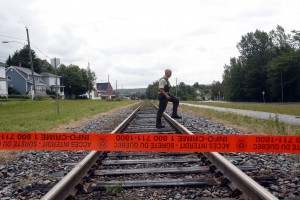Oil Trains Rumble Into Philly, Bringing Dakota Crude, Jobs And Safety Concerns
-
Katie Colaneri
Correction: An earlier version of this story reported that Philadelphia Energy Solutions would be accepting trains carrying 70,000 gallons of crude oil each. The correct volume is 70,000 barrels.
Robert King remembers the very first time he saw an oil train.
“It was April 14, 2013.”
King, a 17-year-old Philadelphian, is a “railfan,” the name for members of a worldwide community of passionate, or some might say obsessive, train buffs.
On that day, King and railfans from the Midwest to the East Coast were busily tracking the inaugural run of a brand new train: the CSX K040, an oil train more than one-mile long hauling raw crude from the Bakken Shale in North Dakota bound for South Philadelphia.
With his camera bag slung over his shoulder, King pedaled his blue-and-white mountain bike to Schuylkill River Park in Center City and up the ramp to a foot bridge overlooking the CSX tracks. Then he settled in to wait. As he stood there, he recalls, “There’s some worry on my mind.”
King fretted that another train slated to use the tracks at the same time might ruin his dream photo. But he got lucky that day, snapping the photo of Philly’s first oil train that you can see on this page.
Nowadays, railfans like King have frequent chances to catch this view.
That’s because Philadelphia is at the center of a new industrial boom. Oil trains are becoming a common sight on tracks between North Dakota and Philadelphia. To get here, they travel through some densely populated areas – Chicago, Albany and New Jersey – which is raising some safety concerns.
Why? These shipments are coming on the same type of train that derailed in Lac-Mégantic, Quebec, last July, leaving 47 people dead and reducing the downtown to smoldering rubble.
Seen in another light, this rail traffic is very good news for America’s energy economy. Rail shipments are booming as fracking in the Bakken Shale continues to yield a glut of light, sweet crude oil.
More traffic, more accidents, more independence
Without enough pipelines to move it all underground, rail shipments have doubled since this time last year, according to the Energy Information Administration.
Fadel Gheit, a senior analyst with the investment bank Oppenheimer, has followed the oil and gas industry for more than 30 years. It has been decades since Gheit has seen this kind of rail traffic.
“Two or three years ago, very seldom you heard that companies were using rail cars. Everybody now is,” he says. “Also the sheer number went from a few hundred rail cars to tens of thousands of rail cars. We have not, to my knowledge, expanded the rail line too much. We have not really spent a lot of money on infrastructure.”
Gheit wonders whether our rail lines can handle all this new activity and whether increasing traffic on the rails will lead to more accidents.
Pennsylvania’s governor, Tom Corbett, prefers to focus on the good news part of the equation. In his own way, the governor is also a rail fan.
Earlier this summer, Corbett paid a visit to ACF Industries – a rail car manufacturing plant in Milton, Northumberland County. The 114-year-old company closed in 2009. But the growing demand for rail tanker cars has pushed its doors wide open again.
“You are part of the piece of the puzzle of how we make this country energy independent of the Mid East,” Corbett told workers that day.
Bakken crude is also a direct cause for the revival of the 140-year-old Sunoco refinery in South Philadelphia. It was set to close when it got new life thanks to a joint venture between a private equity firm and a natural gas company.
In July, the refinery complex now known as Philadelphia Energy Solutions hit a milestone: ramping up shipments to five trains of Bakken crude a week.
July is also when the derailment in Lac-Mégantic happened.

EPA/STEPHEN MORRISON /LANDOV
A Quebec Provincial Policeman crosses the railway tracks inside the exclusion zone in the town of Lac Megantic, Quebec. Hundreds of residents were evacuated from their homes when a runaway train loaded with crude oil exploded on July 6.
Learning from Lac-Mégantic
Inspectors have since concluded that the tankers on that derailed train were mislabeled. Samples from cars that didn’t ignite show the oil inside was actually more flammable than shipping documents reported.
Last week, Canadian transportation officials sent a letter to U.S. regulators warning them that emergency responders may not be getting the right information about these shipments.
But federal regulators have been asking questions about the safety of this boom in rail traffic even before the Lac-Mégantic derailment.
In March, the Federal Rail Administration started planning unannounced spot inspections of crude suppliers and transporters.
Nancy Kinner is director of the Coastal Response Research Center at the University of New Hampshire. She says rail has a fairly good safety record and most incidents are caused by human error “where humans override a system that is designed for protection or don’t believe the data that’s being given to them or simply make a bad judgment.”
Kinner says mislabeled shipments are a prime example of that.
Being prepared
The growing rail shipments pose challenges for local emergency planners trying to prevent accidents or ensure swift, safe clean up.
In Pennsylvania, the Public Utility Commission does spot inspections of tracks, rail cars and shipping documents to make sure transporters are complying with federal rules.
Emergency planning is left to counties.
Immediately after the accident in Canada, Philadelphia’s Office of Emergency Management told StateImpact Pennsylvania it does not get detailed information about rail shipments. Two months later, the agency won’t say whether or not it has gotten any new information or updated its emergency plans.
Federal law does not require railroads to share information about hazardous shipments with them, but Philadelphia Fire Commissioner Lloyd Ayers says CSX regularly communicates with his department about these shipments.
“It’s well before the shipment so we’ll know the chemical or the hazard that’s coming through,” Ayers says. “Where its destination is, where it originated from and what the quantities are so we can be prepared.”
A spokeswoman for the railroad told StateImpact that CSX shares information with local fire departments “upon request.” The railroad also holds training sessions with the Philadelphia fire department every year.
But CSX would not confirm what or even if it’s shipping to Philadelphia Energy Solutions.
The refinery denied a request for an interview about rail safety in the wake of the Canadian accident. But StateImpact did get an invitation to the grand opening of its permanent rail facility and an e-mail from a spokeswoman saying Philadelphia Energy Solutions “enthusiastically supports” safety inspections.
Meanwhile, Energy Solutions CEO Philip Rinaldi says the company is on the verge of becoming the single largest consumer of Bakken oil. Next month, it’ll be welcoming two trains a day, each carrying 70,000 barrels of crude.
Rail fans like Robert King will be out there watching it all unfold and capturing it on film.

















